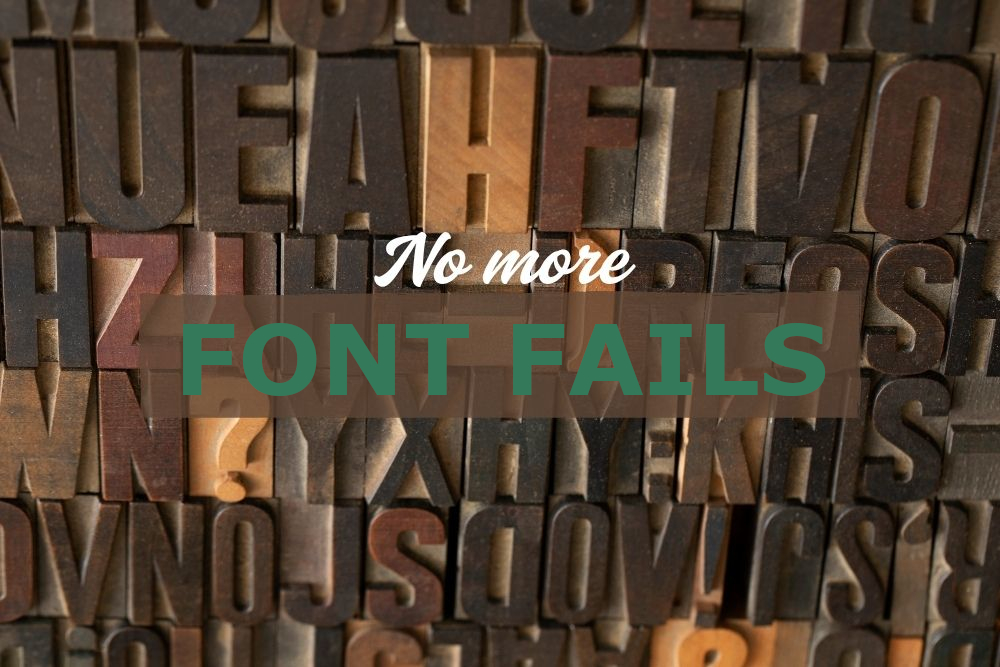Typography is a huge part of branding, but in email design, your choices are far more limited than on the web. While custom fonts may work beautifully on websites, they often fail in emails due to poor support across email clients. That’s where web safe fonts come in.
In this article, we’ll break down why web safe fonts should be your go-to choice for email marketing, what counts as “web safe,” and why using custom fonts usually isn’t worth the hassle — unless you have the technical skills, time, and testing tools to do it properly.
Different Font Families
Firstly, let’s start with an overview of what different font families are.
In typography and CSS, fonts fall into five main families:

- Serif fonts have small lines or strokes at the ends of letters, like Times New Roman and Georgia.
- Sans-serif fonts don’t have these lines—examples include Arial and Helvetica.
- Monospace fonts give every character the same width, like Courier or Roboto Mono.
- Cursive fonts mimic handwriting and are often decorative.
- Fantasy fonts are artistic and unique, like Papyrus.
Monospace, cursive, and fantasy fonts can be harder to read and may not display well on all devices. That’s why web safe fonts usually focus on the more reliable serif and sans-serif types.
What Are Web Safe Fonts?
Web safe fonts are fonts that are pre-installed on the vast majority of devices and operating systems. They’re supported by virtually all major email clients, including Gmail, Outlook, Yahoo, Apple Mail, and others.
Because email clients vary widely in what they support, web safe fonts mainly use serif and sans-serif fonts like Arial, Georgia, and Helvetica. These fonts are readable, widely supported, and ensure your message looks consistent for all recipients. Monospace, cursive, and fantasy fonts might look cool but can cause display issues or be hard to read, so they’re rarely used in email design.
For reliable, clean emails, sticking with web safe serif and sans-serif fonts is the smartest choice.
When you use web safe fonts in your emails, you’re ensuring that:
- Your text will look consistent across devices and platforms
- You avoid rendering errors or fallback issues
- Your email will load faster (no font files to download)
- You don’t accidentally trigger spam filters due to bloated or broken code
List of Common Web Safe Fonts (With Styles)
Here’s a handy list of commonly used web safe fonts grouped by style:
| Style | Font Names |
| Sans-serif | Arial, Helvetica, Verdana, Tahoma, Trebuchet MS |
| Serif | Times New Roman, Georgia |
| Monospace | Courier, Courier New |
The Problem With Custom Fonts in Emails
On websites, custom fonts are relatively easy to implement using @font-face in CSS or by embedding Google Fonts. But email is an entirely different story.
Here’s why custom fonts are problematic in email:
- Poor support across email clients: Most email clients (especially Outlook, Gmail, Yahoo) do not support custom fonts. Only a few (like Apple Mail or some versions of iOS Mail) display them correctly.
- No standard rendering: Even when supported, the font may render inconsistently across devices and platforms.
- Requires fallbacks: You must specify fallback fonts in your CSS to avoid broken layouts. That means writing precise HTML and CSS with font stacks.
- Complicated setup: To use a custom font, you often need to host font files, embed them using CSS, and write advanced code to define font families and fallbacks. This is not beginner-friendly, and even experienced developers sometimes run into issues.
- Load times and spam filters: Custom fonts can increase load time and even affect deliverability, as overly complex or bulky emails can get flagged as spam.

Why Web Safe Fonts Are Your Best Bet
Web safe fonts are fonts that are universally supported across all devices and email clients. They are the safe choice for a reliable, consistent display.
Using these fonts ensures:
- Your email looks good everywhere (no font fallback surprises)
- Faster loading (no external font files to fetch)
- Fewer headaches for you or your developers
- Better compatibility with email clients and spam filters
Fallback Fonts? Only If You Really Know What You’re Doing
Yes, technically, you can define fallback fonts using HTML and CSS, in case your custom font isn’t supported. But:
- You need to write robust HTML email code (which is already fragile and tricky).
- You often have to upload and host the font files yourself.
- You need to test the email thoroughly on multiple platforms and screen sizes.
- Even then, you’re still at the mercy of the email client’s limitations.
In short: Unless you have a dedicated email development team and a testing budget, the payoff is rarely worth the effort.
Final Advice: Keep It Simple, Keep It Safe with Web Safe Fonts
When it comes to email design, don’t let typography sabotage your message. Stick with web safe fonts to ensure your emails are clean, readable, and universally supported.
Yes, they may not scream brand uniqueness, but they ensure your message gets delivered and displayed exactly how you intended.
Want to add personality? Use color, layout, images, and tone, not risky fonts.
